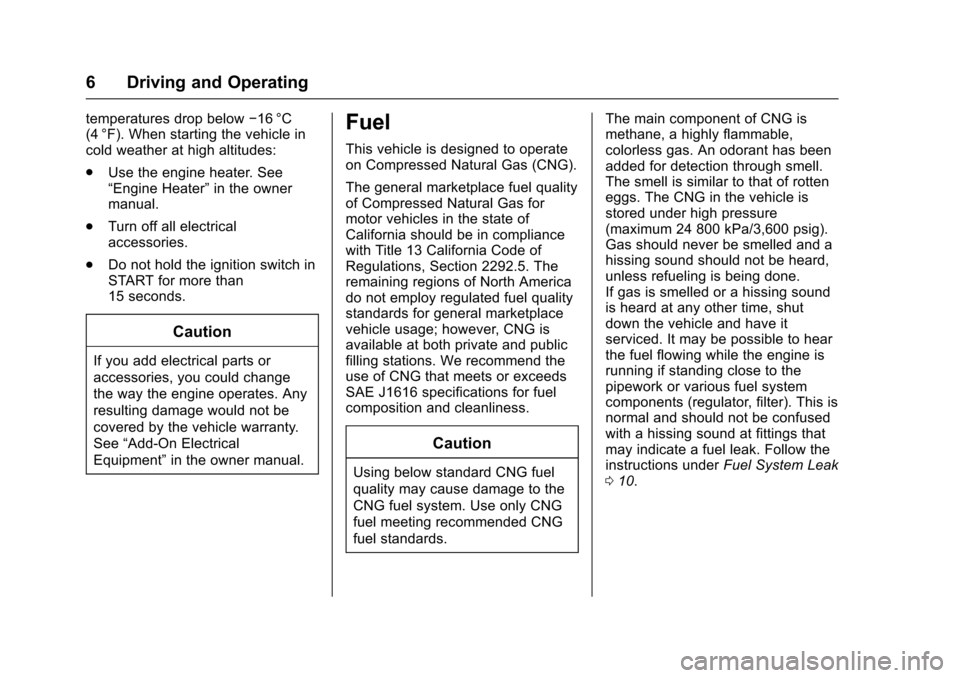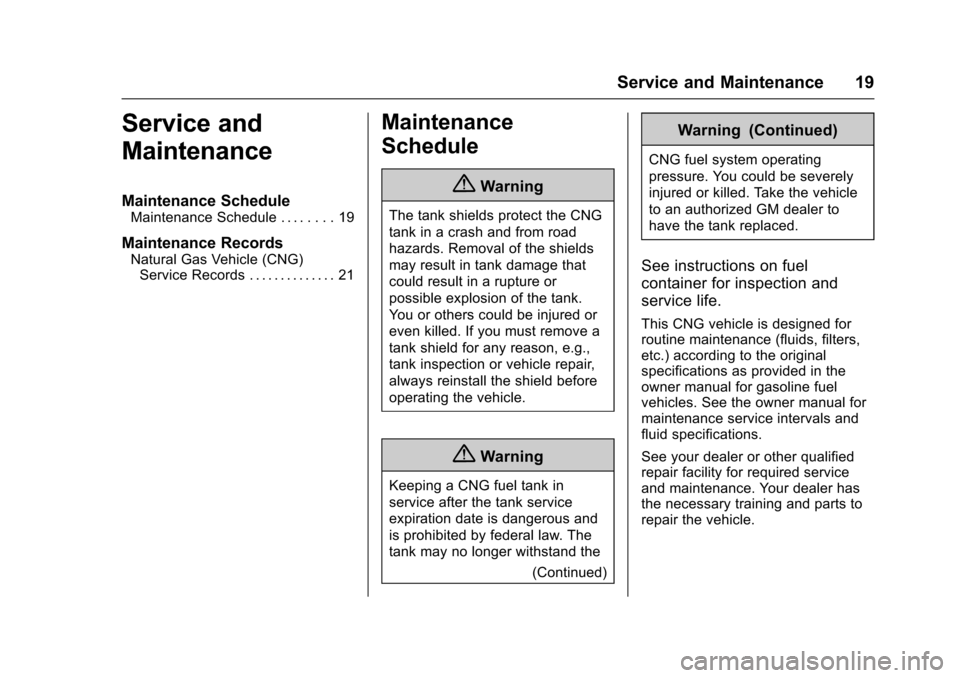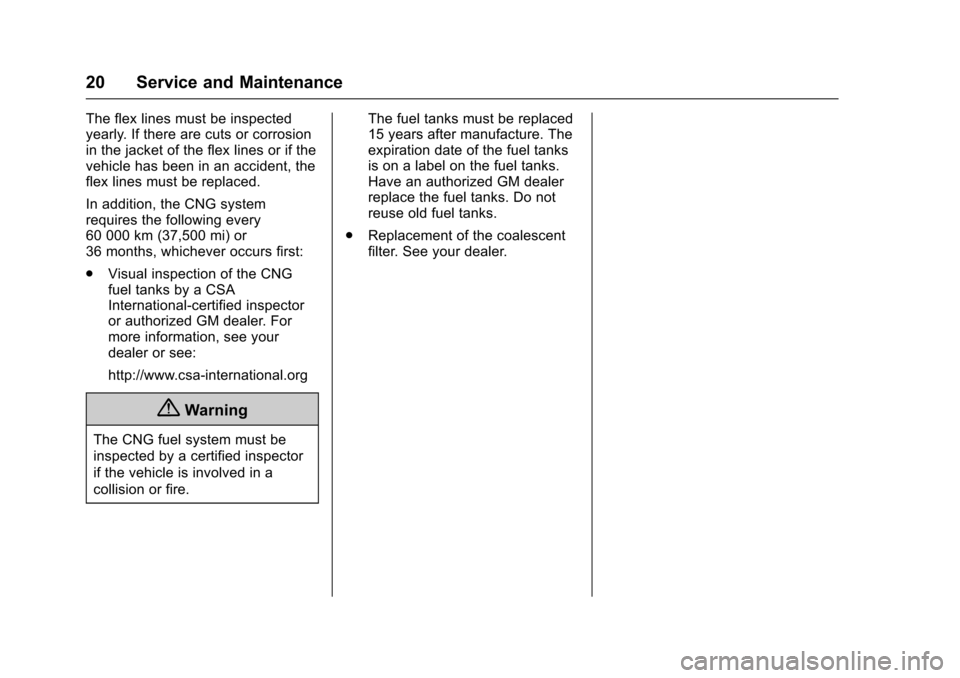fuel filter CHEVROLET EXPRESS CARGO VAN 2016 1.G CNG Manual
[x] Cancel search | Manufacturer: CHEVROLET, Model Year: 2016, Model line: EXPRESS CARGO VAN, Model: CHEVROLET EXPRESS CARGO VAN 2016 1.GPages: 30, PDF Size: 0.63 MB
Page 7 of 30

Chevrolet/GMC Express/Savana CNG Compressed Natural Gas Supplement
(GMNA-Localizing-U.S/Canada-9159237) - 2016 - crc - 6/18/15
6 Driving and Operating
temperatures drop below−16 °C
(4 °F). When starting the vehicle in
cold weather at high altitudes:
. Use the engine heater. See
“Engine Heater” in the owner
manual.
. Turn off all electrical
accessories.
. Do not hold the ignition switch in
START for more than
15 seconds.
Caution
If you add electrical parts or
accessories, you could change
the way the engine operates. Any
resulting damage would not be
covered by the vehicle warranty.
See “Add-On Electrical
Equipment” in the owner manual.
Fuel
This vehicle is designed to operate
on Compressed Natural Gas (CNG).
The general marketplace fuel quality
of Compressed Natural Gas for
motor vehicles in the state of
California should be in compliance
with Title 13 California Code of
Regulations, Section 2292.5. The
remaining regions of North America
do not employ regulated fuel quality
standards for general marketplace
vehicle usage; however, CNG is
available at both private and public
filling stations. We recommend the
use of CNG that meets or exceeds
SAE J1616 specifications for fuel
composition and cleanliness.
Caution
Using below standard CNG fuel
quality may cause damage to the
CNG fuel system. Use only CNG
fuel meeting recommended CNG
fuel standards. The main component of CNG is
methane, a highly flammable,
colorless gas. An odorant has been
added for detection through smell.
The smell is similar to that of rotten
eggs. The CNG in the vehicle is
stored under high pressure
(maximum 24 800 kPa/3,600 psig).
Gas should never be smelled and a
hissing sound should not be heard,
unless refueling is being done.
If gas is smelled or a hissing sound
is heard at any other time, shut
down the vehicle and have it
serviced. It may be possible to hear
the fuel flowing while the engine is
running if standing close to the
pipework or various fuel system
components (regulator, filter). This is
normal and should not be confused
with a hissing sound at fittings that
may indicate a fuel leak. Follow the
instructions under
Fuel System Leak
0 10.
Page 20 of 30

Chevrolet/GMC Express/Savana CNG Compressed Natural Gas Supplement
(GMNA-Localizing-U.S/Canada-9159237) - 2016 - crc - 6/22/15
Service and Maintenance 19
Service and
Maintenance
Maintenance Schedule
Maintenance Schedule . . . . . . . . 19
Maintenance Records
Natural Gas Vehicle (CNG)Service Records . . . . . . . . . . . . . . 21
Maintenance
Schedule
{Warning
The tank shields protect the CNG
tank in a crash and from road
hazards. Removal of the shields
may result in tank damage that
could result in a rupture or
possible explosion of the tank.
You or others could be injured or
even killed. If you must remove a
tank shield for any reason, e.g.,
tank inspection or vehicle repair,
always reinstall the shield before
operating the vehicle.
{Warning
Keeping a CNG fuel tank in
service after the tank service
expiration date is dangerous and
is prohibited by federal law. The
tank may no longer withstand the
(Continued)
Warning (Continued)
CNG fuel system operating
pressure. You could be severely
injured or killed. Take the vehicle
to an authorized GM dealer to
have the tank replaced.
See instructions on fuel
container for inspection and
service life.
This CNG vehicle is designed for
routine maintenance (fluids, filters,
etc.) according to the original
specifications as provided in the
owner manual for gasoline fuel
vehicles. See the owner manual for
maintenance service intervals and
fluid specifications.
See your dealer or other qualified
repair facility for required service
and maintenance. Your dealer has
the necessary training and parts to
repair the vehicle.
Page 21 of 30

Chevrolet/GMC Express/Savana CNG Compressed Natural Gas Supplement
(GMNA-Localizing-U.S/Canada-9159237) - 2016 - crc - 6/22/15
20 Service and Maintenance
The flex lines must be inspected
yearly. If there are cuts or corrosion
in the jacket of the flex lines or if the
vehicle has been in an accident, the
flex lines must be replaced.
In addition, the CNG system
requires the following every
60 000 km (37,500 mi) or
36 months, whichever occurs first:
.Visual inspection of the CNG
fuel tanks by a CSA
International-certified inspector
or authorized GM dealer. For
more information, see your
dealer or see:
http://www.csa-international.org
{Warning
The CNG fuel system must be
inspected by a certified inspector
if the vehicle is involved in a
collision or fire. The fuel tanks must be replaced
15 years after manufacture. The
expiration date of the fuel tanks
is on a label on the fuel tanks.
Have an authorized GM dealer
replace the fuel tanks. Do not
reuse old fuel tanks.
. Replacement of the coalescent
filter. See your dealer.